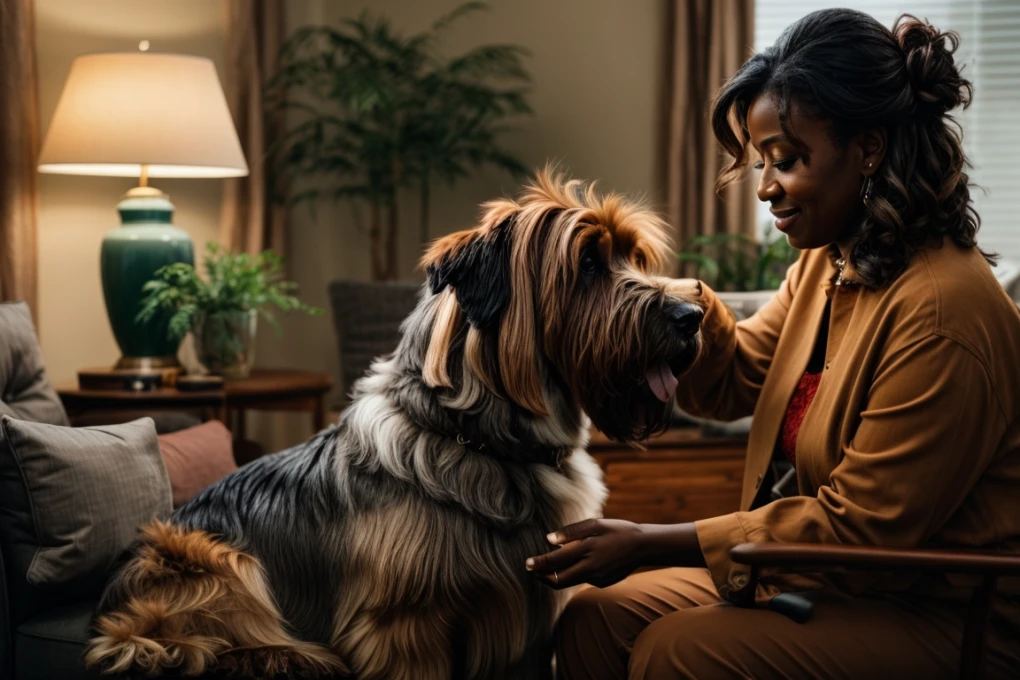Briard Grooming Guide: How to Groom Your Briard Like a Pro

With their long, shaggy coats and loyal natures, Briards make wonderful family companions. But that beautiful fur requires regular grooming to stay healthy and mat-free. Learn how to groom your Briard at home like a professional dog groomer with this detailed guide.
Overview of the Briard Coat
The Briard has a distinctive double coat:
- Undercoat - Fine and soft to protect the skin
- Outer coat - Coarse, long, and either straight or slightly wavy
- Coat length - 6-8 inches is preferred for the show ring, but pet Briards often have slightly shorter coats
- Colors - Black, gray, tawny, or blue, often with varying shades
- Shedding - Briards are average shedders with blowing out their undercoat 1-2 times per year
Puppies have much softer coats that begin to coarsen and cord around 6-9 months old. Proper grooming from puppyhood is essential to prevent matting as their adult coat develops.
Equipment You'll Need
Having the right grooming tools is key to easily detangling and managing your Briard's coat:
- Slicker brush - Fine-toothed for working through the coat
- Rake brush - Helps remove loose undercoat
- Comb - Gets down to the skin and checks for mats
- Scissors - For trimming overgrown fur
- Clippers - Optional for tidying fuzzy feet or pants
- Nail clippers - Trim nails as needed
You'll also need shampoo and conditioner formulated for coarse or textured coats. Ask your groomer for brand recommendations.
How Often to Groom Your Briard
Frequent grooming is a must to prevent mats and keep your Briard looking his best:
- Brush - 3-4 times per week, more often during shedding seasons
- Bath - Every 4-6 weeks or when dirty
- Nails - Trim when you hear them clicking on floors
- Ears - Check and wipe out weekly
Brush outside if possible to contain all the loose fur. Daily brushing may be needed at times when they are blowing their coat.
Step-by-Step Grooming Guide
Follow these steps for grooming your Briard from head to tail:
Before You Start
- Have the dog up on a table or non-slip surface so you don't have to bend over
- Start by running your hands over the coat to feel for any mats
- Spritz coat lightly with de-tangler or water to help with brushing
Brushing
- Use the slicker brush first to gently brush through the entire coat
- Pay extra attention to the legs, pants, and behind the ears where mats often form
- Switch to the rake brush to remove loose undercoat
- Finish by using the comb all the way down to the skin - this checks for any tangles close to the body
Bathing
- Wet the coat thoroughly and massage in shampoo down to the skin
- Let it soak for a few minutes before rinsing - repeat if very dirty
- Follow with conditioner and let sit a few minutes before rinsing clean
- Towel dry as much as possible, then air dry or use a blow dryer on low heat
Drying
- Make sure the coat is completely dry before brushing again
- Use the slicker and comb to remove any tangles that form during drying
- Pay special attention to arm pits, behind ears, and pant area
- Your Briard should be tangle-free once dry if brushed thoroughly
Trimming
- Use thinning shears to neatly trim any excess fur on feet and legs
- Carefully trim overgrown pants around the rear without cutting the skin
- Tidy up the ears and tail as needed to balance the overall look
Nails and Ears
- Use clippers to trim nails, taking just the clear portion of each nail
- Check ears weekly and wipe out any debris using a dog ear cleanser
- Pluck excess ear hair that traps dirt and wax
Regular grooming sessions help you stay on top of your Briard's coat care. Pay extra attention during seasonal shedding periods. Thorough brushing is the key to preventing painful mats from forming close to the skin.
Common Grooming Problems and Solutions
Even with diligent grooming, you may encounter some issues with your Briard's coat:
| Problem | Solution |
|---|---|
| Matted fur | Never force a mat out with a brush - this hurts the dog. Use a de-matting rake carefully or cut out severe mats. |
| Skin irritation | Rule out parasites or allergies. Bathe and rinse thoroughly. Use a soothing oatmeal shampoo. |
| Overgrown coat | If the coat gets extremely long, trim it back carefully in stages to avoid shock. |
| Dirty ears | Keep ears plucked. Clean gently weekly. See the vet if redness or odor persists. |
| Excess shedding | Brush more often. Bathe to loosen old coat. Check for parasites or skin issues. |
Be patient and gentle during grooming sessions. Make them positive experiences with praise and treats. If you need help managing your Briard's coat, don't hesitate to seek professional grooming. With a little practice, you can keep your Briard looking his very best.